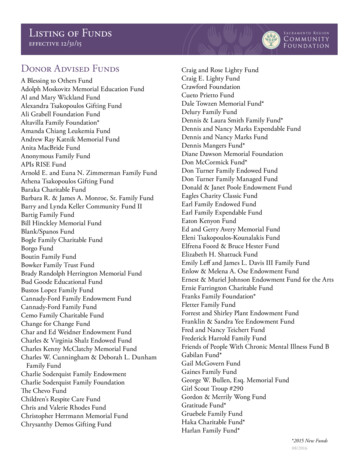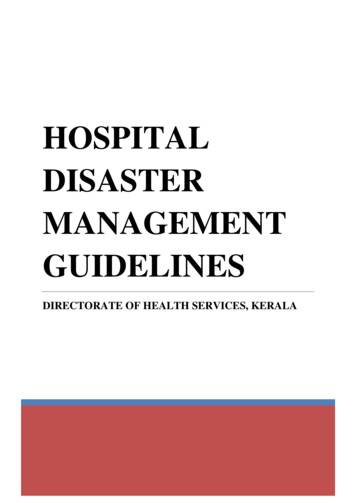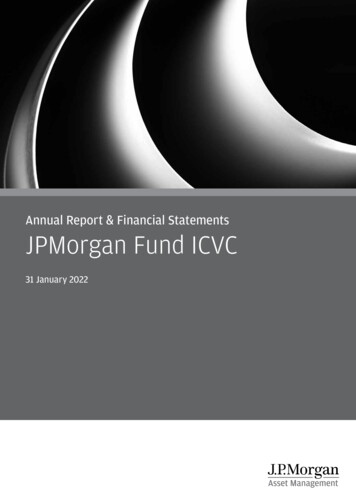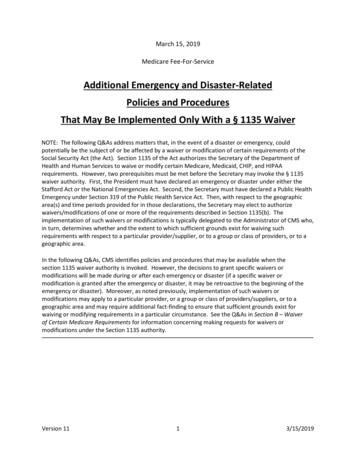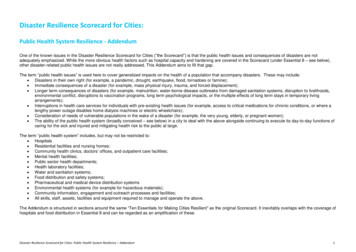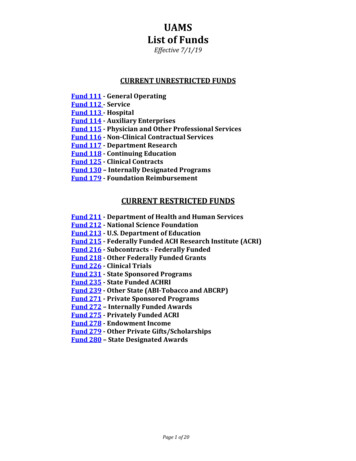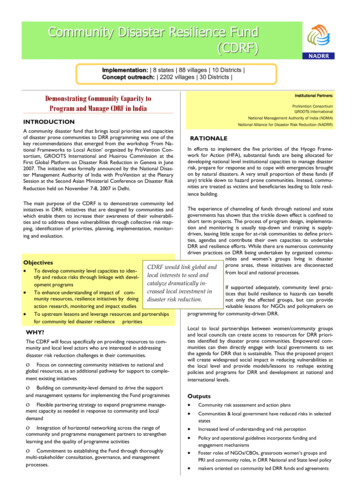
Transcription
Community Disaster Resilience Fund(CDRF)Implementation: 8 states 88 villages 10 Districts Concept outreach: 2202 villages 30 Districts Institutional Partners:Demonstrating Community Capacity toProgram and Manage CDRF in IndiaProVention ConsortiumGROOTS InternationalNational Management Authority of India (NDMA)INTRODUCTIONNational Alliance for Disaster Risk Reduction (NADRR)A community disaster fund that brings local priorities and capacitiesof disaster prone communities to DRR programming was one of thekey recommendations that emerged from the workshop ‘From National Frameworks to Local Action’ organized by ProVention Consortium, GROOTS International and Huairou Commission at theFirst Global Platform on Disaster Risk Reduction in Geneva in June2007. The initiative was formally announced by the National Disaster Management Authority of India with ProVention at the PlenarySession at the Second Asian Ministerial Conference on Disaster RiskReduction held on November 7-8, 2007 in Delhi.RATIONALEIn efforts to implement the five priorities of the Hyogo Framework for Action (HFA), substantial funds are being allocated fordeveloping national level institutional capacities to manage disasterrisk, prepare for response and to cope with emergencies broughton by natural disasters. A very small proportion of these funds (ifany) trickle down to hazard prone communities. Instead, communities are treated as victims and beneficiaries leading to little resilience building.The main purpose of the CDRF is to demonstrate community ledinitiatives in DRR; initiatives that are designed by communities andwhich enable them to increase their awareness of their vulnerabilities and to address these vulnerabilities through collective risk mapping, identification of priorities, planning, implementation, monitoring and evaluation.Objectives To develop community level capacities to iden-The experience of channeling of funds through national and stategovernments has shown that the trickle down effect is confined toshort term projects. The process of program design, implementation and monitoring is usually top-down and training is supplydriven, leaving little scope for at-risk communities to define priorities, agendas and contribute their own capacities to undertakeDRR and resilience efforts. While there are numerous communitydriven practices on DRR being undertaken by organized communities and women’s groups living in disasterCDRF would link global and prone areas, these initiatives are disconnectedfrom local and national processes.local interests to seed andtify and reduce risks through linkage with develcatalyze dramatically inopment programsIf supported adequately, community level praccreased local investment in To enhance understanding of impact of comtices that build resilience to hazards can benefitmunity resources, resilience initiatives by doingdisaster risk reduction.not only the affected groups, but can providevaluable lessons for NGOs and policymakers onaction research, monitoring and impact studiesprogramming for community-driven DRR. To upstream lessons and leverage resources and partnershipsfor community led disaster resilience prioritiesLocal to local partnerships between women/community groupsWHY?and local councils can create access to resources for DRR priorities identified by disaster prone communities. Empowered comThe CDRF will focus specifically on providing resources to communities can then directly engage with local governments to setmunity and local level actors who are interested in addressingthe agenda for DRR that is sustainable. Thus the proposed projectdisaster risk reduction challenges in their communities.will create widespread social impact in reducing vulnerabilities atο Focus on connecting community initiatives to national andthe local level and provide models/lessons to reshape existingglobal resources, as an additional pathway for support to complepolicies and programs for DRR and development at national andment existing initiativesinternational levels.οBuilding on community-level demand to drive the supportand management systems for implementing the Fund programmesοFlexible partnering strategy to expand programme management capacity as needed in response to community and localdemandοIntegration of horizontal networking across the range ofcommunity and programme management partners to strengthenlearning and the quality of programme activitiesο Commitment to establishing the Fund through thoroughlymulti-stakeholder consultation, governance, and managementprocesses.Outputs Community risk assessment and action plans Communities & local government have reduced risks in selectedstates Increased level of understanding and risk perception Foster roles of NGOs/CBOs, grassroots women’s groups andPRI and community roles, in DRR National and State level policy makers oriented on community led DRR funds and agreementsPolicy and operational guidelines incorporate funding andengagement mechanisms
Community Disaster Resilience Fund (CDRF)PROGRESSOrientation Workshop, DelhiCDRF Advisory Group: CDRF advisory groups has establishedin the month of July 2008 chaired by the Member, NDMA. ThisGroup will advocate the concept of CDRF at global, National/statelevels and seek its convergence with key development sector programs namely – NREG, NRHM, JNURM etc.A workshop being held in Delhi on 9th and 10th of December2008 with implementing organizations for CDRF in order to shareand co-create the operational design of the Fund and to receiveideas from experienced NGOs as to how they see the conceptand design of this fund.Community consultations have been held in three states of Maharashtra, Tamilnadu and Andhra Pradesh in June and August 2008.These consultations organized to study the existing Communityfund practices, how are they used and make it sustainable.To initiate the CDRF pilot with grassroots communities, a national workshop on "Baseline on Community Resilience "beingheld in New Delhi from Feb 24th to 25th 2009 with project partners. Participants were from multi hazard zones from variousstates to address the DRR initiates by grassroots communities.Community Consultations: Consultation team had visited TamilNadu in May 2008 and held a series of meeting with Farmers Federation, Poompuhar Nagapattinam district to explore how they areusing community fund.In June 2008 team visited Nanded and adjoining areas to see howCommunity fund is working. Again in 2008 August ROSE in Tamilnadu where they have a scheme implementing with community haveconsulted. A visit was made to Sanghamitra, Andhra Pradesh andheld discussion on community fund practices, challenges and experience.Inviting and short listing proposals:Workshop on "Resilience baseline"The workshop on resiliencebaseline have organized inDelhi on February 24-25,2009. The workshop was alearning experience for implementing partners on the collection of data on resilienceby community, documentation and reporting format andactivity plan.Building on community action for riskInvitation for submitting proposals have beenreduction as the starting point, the Community led DRR Pilotssent to 20 selected organisations from variousCDRF will be able to support netstates in August 08. The selection criteria forThe community groups have started theinviting proposals based on the initiatives ofworked initiatives at the needed scale.pilots with formation of CDRF committee,these organizations in DRR, innovativeness,channelization of fund to the community,scale, gender equity, potential impact, involveassessment of hazard, vulnerabilities and available resources in thement of women and youth, partnership with local and state governvillage, dialogue with local govt, etc.ments.Selection of CDRF pilots:Selection committee has received11 proposals from various states.In December 2008 Advisory committee was convened under thechair of NDMA to review theproposals. The review membersasked organizations to revise andstrengthen the proposal for scaleup, linking with local government, institutionalizing CDRF committee etc. The revised and final proposals have received in the monthof January and selection process was completed in the same month.Finally 8 proposals have been selected for implementing CDRF pilot.The selected organizations for the pilot were from multiple disasterprone areas such as earthquake, tsunami, cyclone, flood, drought,heat wave.Facilitation & Technical AssistanceNADD supported implementing organizations and community groups:οοοοοοAssist in risk assessmentCapacity building workshopsLeveraging local resourcesOrganise policy dialogue workshopsDiscussion forums and case studiesHosting and sharing of CDRF knowledge throughNADRR website www.nadrrindia.org.Selected organisations:1. Rural Volunteers Centre (RVC), Assam2. Institute o f Development Support (IDS), Uttarakhand3. Sanghamitra Service Society, (SSS), Andhra Pradesh4. Covenant Centre for Development (CCD), Tamilnadu5. Urmul Trust, Rajasthan6. Saurashtra Voluntary Actions (SAVA), Gujarat7. Kanchan Seva Asharam (KSA), Bihar8. Udyama, OrissaVisits are underway to see the community led initiatives inDRR in selected states. A case study and learning notewould be publishing soon.
ene opis th zahciarganpprokRF a unity o ard maDCmweomthtoectofngKey ement o ead cha fer.lgaos satgeniyeread mmunitsnti or cotheiingCommunity Disaster Resilience Fund (CDRF)PILOTS & IMPACTSHazards: Earthquake, Floods, Cyclone, Tsunami, LandslidesImplementingOrganisationThe HazardThe BigIdeaRole ofwomen’sgroupsInstitute forDevelopmentSupport (IDS),UttarakhandOver exploitation andinappropriatemanagementof naturalresourcesSevere erosion, dryingup of waterssourcesConservationand management of natural resourcesfor sustainable livelihoodsPlan, implement, andmonitor theproject; Ensure community contribution in theform of labor,networkingwith localgovt for mobilization offunds, procurement ofmaterials etcLoss of cropsin recurrentdrought andfloodsCreate community ownership inDisaster RiskReductionwith the active involvement of CommunityGroups, localgovernment,PanchayatiRaj Institution& otherstakeholdersWomen willlead thisinitiative.Participate inPRIs & Governmentmeetings,taking uptraditionalagriculturepractices foreffectivesocioeconomicdevelopmentCDRF committee will beformed, InvolveSHGs in firstphase; Providetechnical support and equipthem for resource mobilization, Leverage governmentschemes andproper utilization of CDRFfund.Non availability of fodderfor livestockand foodsecurityTo promotefodder forlivestock atlow cost thrucultivation of“Sevan”grass indrought affected regionWomen’sgroup willhave a majorrole to playalong withyouth groupsand PRIsRecurrentfloods andloss of cropsPromote andinstitutionalizeCommunityBased Disaster Risk Reduction(CBDRR)and WatSansecuritythrough community capacity andownershipbuilding;Active involvement ofwomen’sgroups indisaster taskforces, andCDRF monitoring committees;Participateand establishtheir voicesat Gramsabhas andother forumsImplementation: 6 villagesin 1 districtConcept outreach: 50 villages in 2 districtsKanchan SevaAshram,(KSA), BiharImplementation: 30 villagesin 1 districtConcept outreach: 50 villages in 2 districtsURMUL Trust,RajasthanImplementation: 3 villagesin 1 districtConcept outreach: 900villages in 2districtsRrural Volunteers Centre(RVC), AssamImplementation: 3 villagesin 1 districtConcept outreach: 900villages in 2districtsWho holds thefund and howdo they implement it?The funds willbe transferreddirectly to village development committee(VDC)Link to mainstream development programmesLink local government ontechnical assistance such asproviding fundfor soil, waterconservationwork; Trainingand capacitybuilding ofcommunity incontrollingforest fire.OutcomesAssessment ofdisaster risksincluding hazards,vulnerability andcapacities; Training for selectedwomen groups;Developing disaster preparednessplan; Organizinglearning exchanges; Cultivation of traditionalvegetables andmarket linkageProvide longterm effectiveness throughparticipatoryinvolvement ofPRI, Government schemesviz. NREGA,SGSY, DRDA,NRHM etc.Dialogue, learning sharing withthe local administration forleveragingresourcesEnhanced resilienceto disasters; Reduction on loss of lives &livestock; Betterdisaster preparedness and response;Integration of DRRand resilience building into communitydevelopment; Emergent of Leaders atthe GrassrootsURMUL Seemant will facilitate with community in Kolayat block toform the CDRFcommitteeAssessment ofhazards, vulnerability and capacities; Training oncultivation ofSevan grass;Training on waterharvesting;Training and Capacity; building onDRR;Water harvesting;Fodder developmentTo link govt’sdrought reliefprogrammes toreduce unemployment problem, Leveragelocal resourcesfor water harvesting andcleaning ofpondsLess mortality oflivestock; Fodderdevelopment andavailability in thecrisis time; Reduction in forced andstress migration; Todevelop fodder growing a communitypractice and incomegeneration;A committeewill be formedto implement,monitor andevaluate theinitiative withactive involvement of community groups. Theinitiative will befacilitated by thelocal CBO.Assessment ofdisaster risks;Constitution, capacity building andpromotion of village based DPSand task-forces;Construction andpromotion of Floodresilient WatSanstructures, Promotion of grain bank;Creating opportunity for thecommunity todialogue andshare therelearning withPRIs, localgovernment toincorporateDRR in developmentschemes viz.NREGS, RSVY,IAY, TSC etc.Sustainable model toaddress risk of disaster; State leveladvocacy to reducethe risk of disastersin 21 flood vulnerable and flood affected districts ofAssam;The sector wise taskforces (TF) will beequipped, and functional in 15 floodaffected villagesInitiativesAssessment ofdisaster risksincluding hazards,vulnerability andcapacities.Plantation of thefuel and fodderspecies; Construction of checkdams, gully plugging, water bodiesAvailability of fuel,fodder, timber;Controlled soil erosion Minimized riskof forest fire; Reduction in women drudgery; Sustainability ofwater sources
beDRF willt of the Caenmdpanlod deveexperienceDesign anom pastssfrcegroinpnlearltationbased onolder consuulti-stakehmydloabrCommunity Disaster Resilience Fund (CDRF)ImplementingOrganisationThe HazardThe BigIdeaRole ofwomen’sgroupsWho holds thefund and how dothey implementit?InitiativesLink to maistream development prorammesOutcomesCovenantCentre forDevelopment(CCD) TamilnaduLack ofknowledgeand awareness ontraditionalDRR andresiliencerelated practicesDocumenttraditionalDRR andresiliencepractices;Focus onlivelihoodsecurity;Fund mobilization athouseholdand community levelsSoranamfederation willbe activelyinvolved inthis process.Master Trainers will bedevelopedand trainfurther trainother communitiesFund will belocated inSooranamfederation; Anetwork consisting of womenmembers fromall 13 federations in droughtprone coastaland hilly areaswill be formedfor effectivesharingBetter market forthe raw materialswhich is sea shell,palm leaves andcoir;CreateToT on businessskills, communityorganisation andDRR;Organise womengroups thru clusterand federationExisting collaboration withlocal government will bestrengthenedExisting knowledgebase in a localizedmanner gets documented, shared andvalidated;Women’s perspective in DRR andResilience buildingget highlighted.Prone tonatural disasters likecyclone,earthquake,drought andsalinity ingressWomenbecome partof development activities andDRR strategy: Reducedisaster risksthroughstrengtheningsocial security structure;Promotion ofprimaryhealth andsanitationTo train communities increatingshelter beltwith egenerationand resourcemobilizationby Sangamam TaskForce FederationThe projectwill be implementedthroughwomen’sgroupsLocal CBO willtransfer thefunds towomen’s SHGs;The programwill be implemented though45 womengroups of 3blocks; Ninedemonstrationswill be held in12 womengroupsAssessment ofdisaster risksincluding hazards,vulnerability andcapacities;Recharge pits forwater conservation, application ofmicro drip & sprinklers;Bore well sealingand cultivation ofsalt resistant cropsLinkage withlocal government on providespecific supports in thetrainings;StrengtheningNREG, PDS,MDM & othersocial securityschemes; Maintenance ofmicro drip irrigation systemsPromotion and marketing of insuranceproducts; Strengthening NREG, PDS,MDM & other socialsecurity schemes;Recharge pits forwater conservation;Application of microdrip & sprinklers;Bore well sealingand cultivation of saltresistant cropsMembers of 2fish vendingwomen’sfederationsas well asmembers ofdisaster taskforce federations will beinvolved inprocessThe fund will betransferred toSANGAMAMfederation inturn they willtransfer to thetwo proposedCBOs.Hazard/Vulnerability/Capacity map of 4villages; ShelterBelt with mixedplantation in 15acres; Conservation of Mangrovesin 20 acres ;Creation of Trainers in mangroveconservation,Disaster task forceand shelter beltPRIs will encourage byCBO membersand communities. Periodicalparticipation ofPRI members inreview meetings;Help from govtdepartment incapacity building, supportingwith the specificschemes etcCreation of 20 Master community resource persons /trainers; 52 trainersin shelter belts andconservation ofmangroves;Conservation ofMangroves in 20acres; Shelter Beltwith mixed plantationin 15 acres; to provide alternativelivelihood optionsTo accelerateagriculturedevelopment;To use thefund indrought andflood proneareas forcommunitysafety nets inaddressingthe criticalsupport forseeds, nutrition, etcWomen willplay majorroles facilitated byCBOs andFos; Theentire process will bedone bywomenfolks/groupsthose whoare workingdirectly withcommunity inacceleratingself-helpprocessFunds will behandled by acommitteerepresentingCBO and community groupsAssessment ofdisaster risksincluding hazards,vulnerability andcapacities; Grainbanks ; Coastalplantations; Nursery raising; Community fish culturefor income andnutrition; Paddycultivation by SRImethod, ecofarmingCoordinationand partnershipbuilding withPRIs and localauthorities aswell as advocacy, awareness building,handholdingTo accelerate agriculture developmentfor drought and floodprone areas; Morethan 2500 membersfrom 30SHGs/Federation willbe benefited directlyfor the Livelihoodpromotion; 15 villages will be facilitated for communitysafety nets; At least1000 families will beaddressed fromDistress Migration inthe drought andflood prone area in 3districtsImplementation: 6 villagesin 1 districtConcept outreach: 400villages in 7districtsSaurashtraVoluntaryAction (SAVA),GujaratImplementation: 9 villagesin 1 districtConcept outreach: 42 villages in 2 districtsSanghamitraService Society (SSS),AndhraPradeshRecurrentfloods, cyclones, tsunami;Implementation: 4 villagesin 1 districtConcept outreach: 10 villages in 2 districtsUdyama,OrissaImplementation: 15 villagesin 3 districtConcept outreach: 150villages in 10districtsRecurrentfloods,droughtscyclone, heatwave
Community Disaster Resilience Fund (CDRF)Facilitating organizations:Swayam Shikshan Prayog, Mumbai Knowledge Links, DelhiNational Alliance Disaster Risk Reduction (NADRR)C/o SEEDS15 A, DMA BuildingSector 4, R. K. PuramNew Delhi -110063IndiaTel.: 91- 11- 26174572 / 4272E: info@nadrrindia.org
1. Rural Volunteers Centre (RVC), Assam 2. Institute o f Development Support (IDS), Uttarakhand 3. Sanghamitra Service Society, (SSS), Andhra Pradesh 4. Covenant Centre for Development (CCD), Tamilnadu 5. Urmul Trust, Rajasthan 6. Saurashtra Voluntary Actions (SAVA), Gujarat 7. Kanchan Seva Asharam (KSA), Bihar 8. Udyama, Orissa


